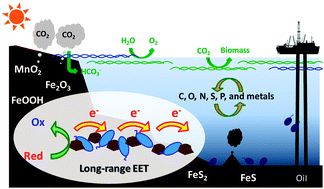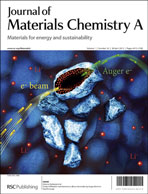Although nanocrystalline Fe(III) oxides are abundant in natural minerals, few studies have noticed their biological significance from the view point of semiconductive properties. To examine the roles of semiconductive Fe(III) oxides in the respiratory activity of microorganisms, we cultured the Fe(III)-reducing bacterium Shewanella loihica PV-4 in an electrochemical cell and examined the influence of cell surface-associated Fe-oxide nanocolloids on the extracellular electron transfer (EET) efficiency. It was found that the respiratory current was greatly improved (over 40 fold) when α-Fe2O3 or α-FeOOH was supplemented into the cell cultures. In contrast, only a small improvement (less than 4 fold) was observed after the addition of Fe3O4 and γ-Fe2O3. It was also found that the outer-membrane c-type cytochromes (c-Cyts) of Shewanella cells had a midpoint potential close to the conduction-band edge of α-Fe2O3 and α-FeOOH, whereas a large energy separation existed for γ-Fe2O3 and Fe3O4. These observations support the recently proposed model for bacterial long-distance EET (R. Nakamura, et al., Angew. Chem., Int. Ed., 2009, 48, 508–511), in which c-Cyts serve as electrical linkages between nanocolloids, allowing the cell population to exploit semiconductor-mediated electron-hopping. Support for this model was also provided by the mutational experiments of outer-membrane c-Cyts and the clear percolation behavior on the formation of conductive networks with respect to the amount of loaded colloids. Thus the EET mediated by semiconductive nanocolloids highlighted the microbial ability to take advantage of semiconductor-based electrochemistry for respiratory activities.

You have access to this article
 Please wait while we load your content...
Something went wrong. Try again?
Please wait while we load your content...
Something went wrong. Try again?


 Please wait while we load your content...
Please wait while we load your content...